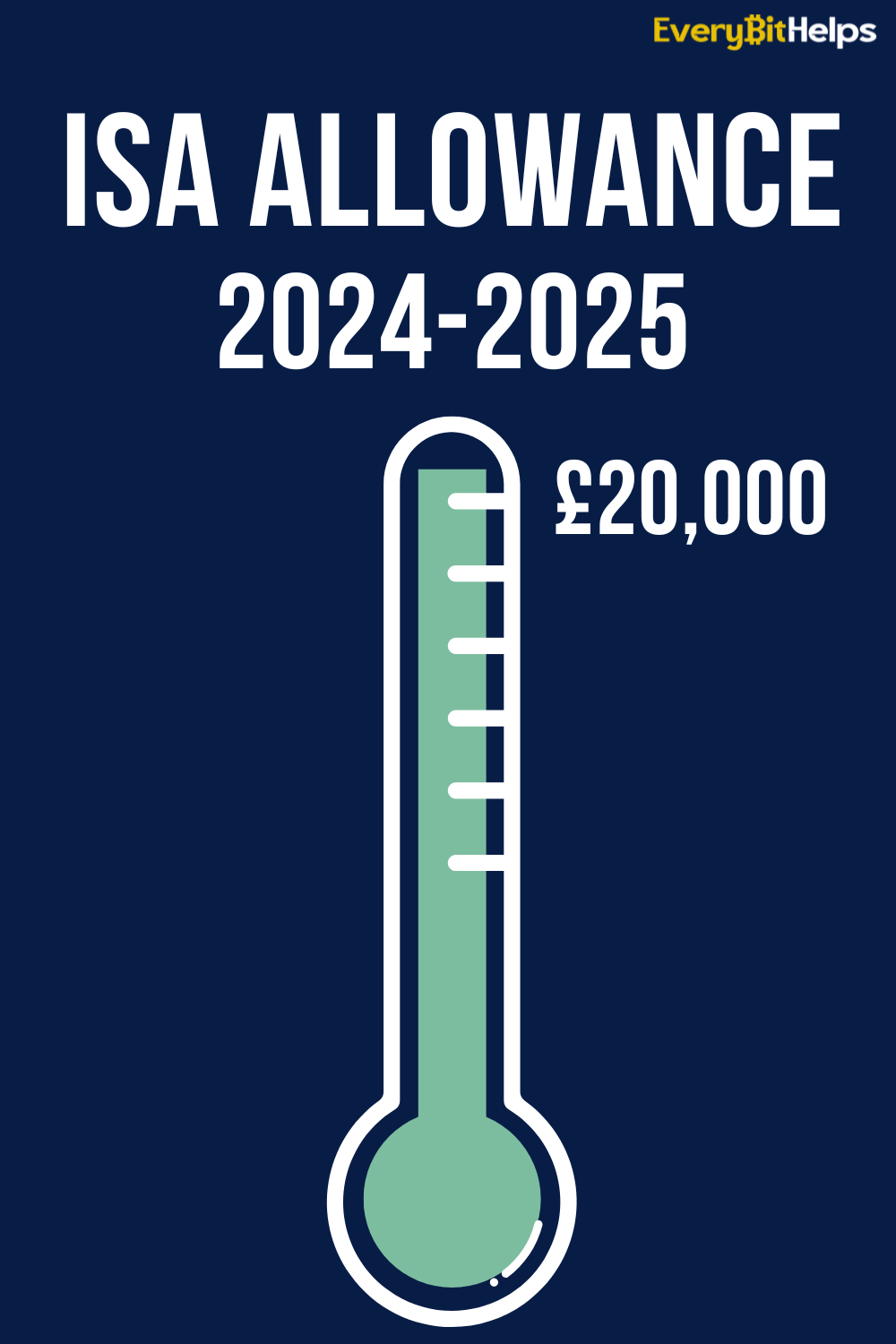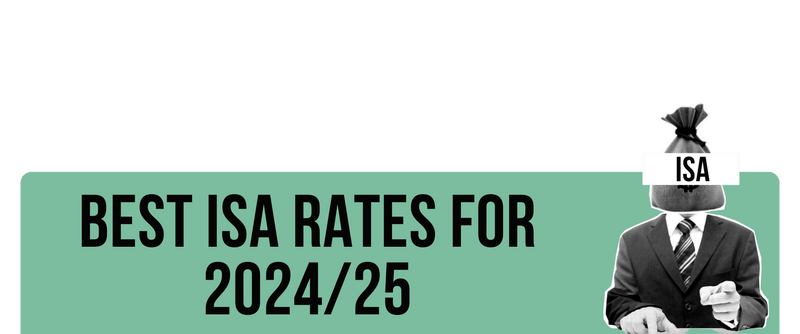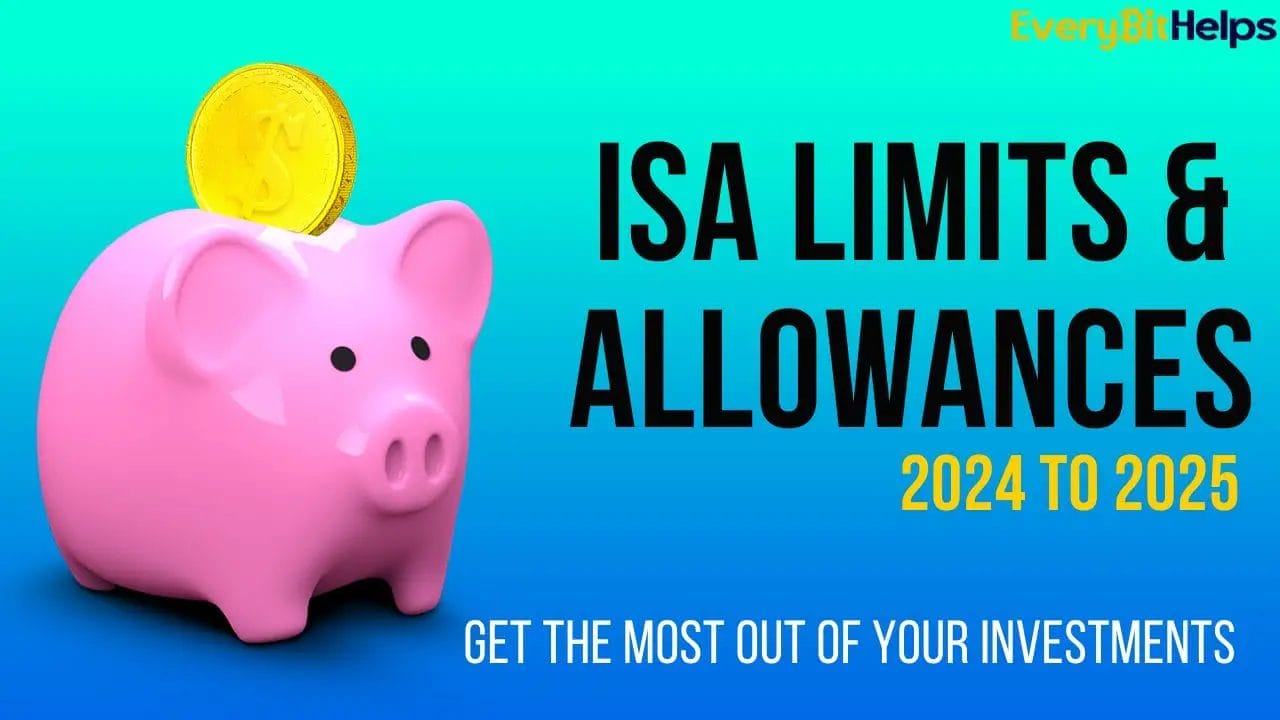In this guide, we will explain ‘what are the ISA limits and allowances for 2024/2025′ and reveal the key conditions and restrictions involved in using them. Plus, we’ll discuss what an ISA is and outline the key benefits of depositing money into an Individual Savings Account. It’s also important to remember there are ISA limits and allowances, so we
Amid the ongoing cost-of-living crisis, savers are considering ways to benefit from owning tax-efficient investment accounts. One of the most popular tax-wrapped accounts is an Individual Savings Account, also known as an ISA.

ISA Limits & Allowances 2024/25
The UK financial tax year 2024 to 2025 ISA limit will be £20,000. This means you can invest a maximum of £20,000 into your ISAs for the tax year.
| ISA Type | ISA Limit 2024/25 |
|---|---|
| Adult ISA | £20,000 |
| Lifetime ISA | £20,000 |
| Junior ISA | £9,000 |

Aside from the primary ISA limits and allowances already stated, there are a few extra details users should be aware of before creating their first ISA account. These include:
Who can open an ISA?
To open an ISA, investors must be:
- 16 or over for Cash ISAs
- 18 or over for Stocks and Shares or Innovative Finance ISAs
- 18 or over but under 40 for Lifetime ISAs
Investors must also be either:
- A resident of the UK
- Crown servant or their spouse or civil partner if you do not live in the UK.
Can I pay into more than one ISA?
You can only pay into one Stocks & Shares ISA and one Cash ISA a year, splitting your ISA allowance between them. You can’t pay into multiple Stocks & Shares ISAs or Cash ISAs.
Can I create more than one ISA?
Unfortunately, for those hoping to game the system by creating multiple ISA accounts, the £20,000 allowance applies per person, not per account. With that said, there are no rules against allocating a portion of your savings to a spouse or family member who might not have used their full ISA allowance.
Who can open a Junior ISA?
Only a child’s parent or legal guardian can open a Junior ISA account. Once the account is created, the parent or guardian can share the information, allowing family members and friends to contribute to it.

What is an ISA?
Let’s start with the basics and answer the question: what is an ISA? ISA stands for Individual Savings Account and is an investment vehicle that allows UK residents to accumulate tax-free earnings from their savings.
ISAs were introduced in 1999. These accounts incentivise long-term financial growth through ringfenced tax allowances. The amount allowed to be invested can differ from year to year. For those looking to collect interest from their investments that exceed their capital gains tax allowance (currently standing at £12,300), ISAs are a great way to ensure your profits are fully protected.
To cater to the multiplicity of savings goals, a few different types of ISA are available to investors. These variations include how your money is invested and your end goals when it comes to your investments.
In each case, there’s a range of ISA limits and allowances to consider when taking advantage of this year’s tax-free benefits.

What are the Different Types of ISAs?
When creating your first ISA account, you must consider your time horizons and decide which investment style best suits you. In short, when would you prefer to cash out on your returns?
If you plan to withdraw your money soon, a Cash ISA might be the safer approach. If, on the other hand, you won’t be touching your investments for a decade or more, it’s worth maximising your returns using a Stocks and shares ISA.
The two approaches are described in further detail below.
Cash ISA
Similar to a regular savings account that you’d open with your bank, a cash ISA offers the choice of a fixed or variable rate. While offering lower returns than their alternatives, Cash ISAs are a good option for people who don’t want to deal with the uncertainty caused by stock market volatility.
Stocks & Shares ISA
With inflation levels rising fast, those looking to maximise their investment returns would be encouraged to explore the available Stocks and Shares ISA options. In contrast to Cash ISAs, your contributions are actively invested in the stock market. While this holds the potential for higher returns, it also increases risk, as your money can go up and down due to the inherent fluctuations in equity prices.
It’s, therefore, important to ensure you won’t need the money in the short term, as you might end up cashing out at a loss.

How much can I Invest in an ISA?
Having established the key differences between the Cash ISA and the Stocks & Shares ISA, it’s now time to answer the question of ‘How much can I invest in an ISA for 2024/2025?’
We’ll break down each individually because there are multiple ISA options with varying tax implications.
| ISA Type | ISA Limit 2024/25 |
|---|---|
| Adult ISA | £20,000 |
| Lifetime ISA | £20,000 |
| Junior ISA | £9,000 |
Adult ISA Limit
For the 2024/2025 tax year, the maximum contribution to an ISA allowance is £20,000. Deposits exceeding this amount will typically be housed in a General Investment Account (GIA), which is liable to income and capital gains tax.
This £20,000 limit is absolute, so while you may split your allowance across multiple ISA types, you won’t be able to pay more than this amount across one tax year.
The standard ISA allows users to deposit and withdraw money as often as they want freely.
Example: You could save £15,000 in a Cash ISA and £3,000 in a Stocks and Shares ISA in one tax year without incurring any taxes.
Lifetime ISA Limit
A lifetime ISA, also known as an LISA, allows a maximum contribution of £4,000 per tax year. Designed to help people save for their first home or retirement, the Lifetime ISA is a generous incentive for people looking to hit either financial milestone.
In 2022, beneficiaries can collect a 25% bonus from the government, up to a maximum of £1,000 for each tax year. This money is collected month-by-month and can only be withdrawn for the purposes already stated, or else you’ll need to pay a sizeable penalty charge.
Example: If you put £1,000 into your Lifetime ISA, the government will add an extra £250. This would leave you with £1,250 at the end of the tax year.
Junior ISA Limit
The maximum you can contribute to a Junior ISA is £9,000 per tax year. If more than this is put into a Junior ISA, the excess is held in a savings account in trust for the child.
A Junior ISA, frequently shortened to JISA, is a long-term savings account created by a parent or guardian on behalf of a child. To help encourage good saving habits, these accounts are locked until the child turns 18. After that, they will automatically be rolled over into an adult ISA, enjoying the freedoms already stated.
By starting their investment journey early, children can be set on the path to a healthier financial future.
Example: Your child could save £5,000 in a Junior Cash ISA and £4,000 in a Junior Stocks and Shares ISA in one tax year without incurring any taxes.

Best ISA Rates for 2023/24
We’ve identified some of the best Cash and Stocks and Shares ISAs available for investors in 2023/24. Our shortlist details the interest rate offered, minimum contribution requirements, and the Trustpilot rating.
Best Cash ISA 2023/24
| Provider | Rate | Minimum Contribution | Trustpilot Rating |
|---|---|---|---|
| Halifax | 3.10% | Open with £1+ | 1.6 |
| Yorkshire BS | 3.35% | Open with £1+ | 1.9 |
| Coventry BS via Hargreaves Lansdown | 3.25% Plus Cashback | Open with £10,000+ | 4.3 |
| Nutmeg | 3.50% | Open with £500+ | 3.9 |
Best Stocks & Shares ISA 2023/24
| Provider | Fees & Charges | Trustpilot Rating |
|---|---|---|
| Nutmeg | – 0.45% or 0.75% up to £100k – 0.25% or 0.35% on amounts above | 3.9 |
| Hargreaves Lansdown | – Up to 0.45%/yr in platform charges – Plus an £11.95 share dealing charge | 4.3 |
| Interactive Investor | – £9.99/mth in platform charges – Plus £7.99 share dealing charge | 4.7 |
| Wealthify | 0.60% | 4.4 |
ISA FAQs
What is the ISA Deadline for 2023/2024?
The deadline for using your ISA allowance for 2023/2024 was on the 5th of April, 2024. As a tax wrapper, the ISA allowance runs in parallel with the UK tax year, which runs from the 6th to the 5th of April (the end of the UK financial tax year). After this date, your tax-free ISA allowance for 2023/24 will come to an end.
What is the ISA Deadline for 2024/2025?
The deadline for using your ISA allowance in 2024/2025 is April 5th, 2025. As a tax wrapper, the ISA allowance runs in parallel with the UK tax year, which runs from the 6th of April to the 5th of April (which is the end of the UK financial tax year). After this date, your tax-free ISA allowance for 2024/25 will end.
What happens to my ISA when I die?
It might not be something you want to think about, but many ISA customers would be interested to know ‘what happens to my ISA when I die?’ When you pass away, your Stocks and Shares ISA will become classed as a ‘continuing ISA’ for a period of time.
It will remain open until the administration of your estate is completed or the ISA is closed by your executor. You can check out the HMRC website if you want more information.
What happens to your ISA at the end of the Tax Year?
Your ISA allowance will replenish at the end of each financial tax year, and your account will remain open. You’ll keep your savings tax-free for as long as you keep the money in your ISA accounts.
How do I withdraw from a Lifetime ISA?
Offering a generous government bonus to help you with your savings milestones, Lifetime ISAs are a great way to accelerate your journey towards retirement or owning your first home. But many customers want to know – ‘How do I withdraw from a Lifetime ISA?’
If you’re looking to buy your first home, you must complete a declaration form provided by HMRC, fill it out, and give it to your property conveyancer. The funds will then be processed within 30 days of receipt. You can also withdraw from your Lifetime ISA once you reach 60 or if you’re terminally ill.
If you want to withdraw for any other reason, you’ll have to pay the government withdrawal charge of 25% – which could mean you get out less than you put in.


